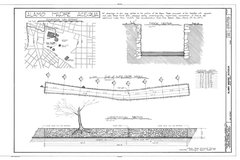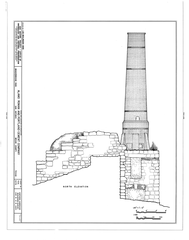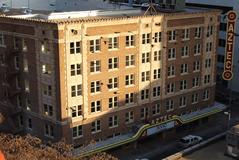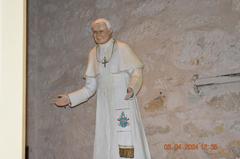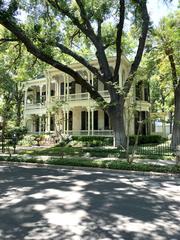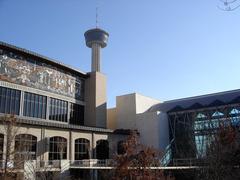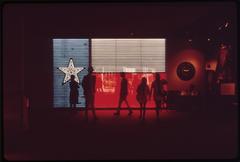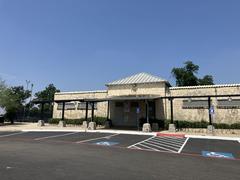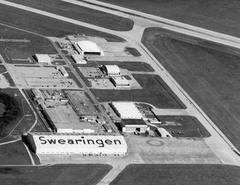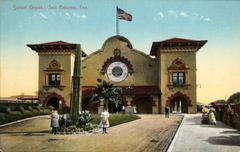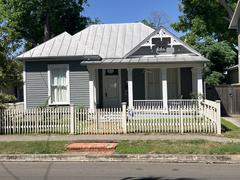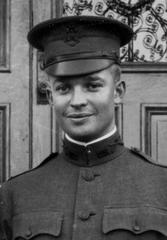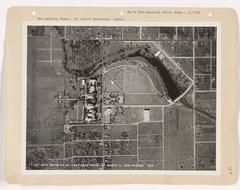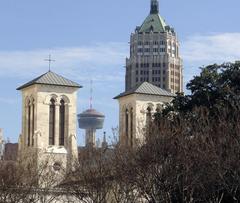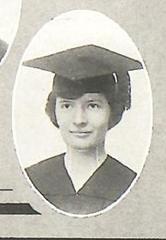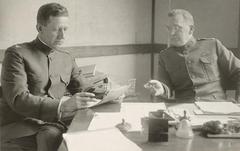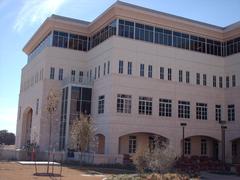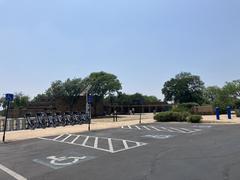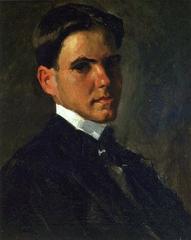Ruiz-Herrera Cemetery: Comprehensive Visiting Guide, History, and Cultural Significance in San Antonio
Date: 14/06/2025
Introduction
The Ruiz-Herrera Cemetery, nestled in San Antonio’s culturally vibrant landscape and the surrounding Bexar County, stands as a lasting testament to the region’s deep Hispanic, Tejano, and indigenous roots. With origins dating back to the 19th century, this historic site offers visitors an illuminating look into local history, from its Spanish colonial beginnings to its role in pivotal Texas events. The cemetery—also known as the Antonio Casias - Ruiz-Herrera Cemetery—serves not only as a burial ground but also as a living chronicle of the families and traditions that shaped South Texas (historic.one; Waymarking.com).
This guide provides a detailed overview of the cemetery’s historical context, practical visiting information—including hours and accessibility—its cultural importance, and preservation efforts, ensuring a meaningful and respectful visit for all.
Table of Contents
- Introduction
- Early Settlement and Historical Context
- Cemetery Origins and Notable Families
- Historical and Cultural Significance
- Visiting Hours, Tickets, and Accessibility
- Site Features and Visitor Experience
- Cultural Traditions and Community Events
- Notable Interments and Genealogical Value
- Preservation and Community Stewardship
- Practical Tips and Safety
- Nearby Attractions
- Frequently Asked Questions (FAQ)
- Conclusion and Call to Action
- References
Early Settlement and Historical Context
Before European contact, Bexar County was home to Native American groups, including the Coahuiltecan and Lipan Apache. Spanish colonists established a foothold with the founding of Mission San Antonio de Valero (the Alamo) in 1718, marking the start of centuries of dynamic cultural exchange. After Mexico’s independence in 1821, the region became a center of Tejano settlement, and by 1836, it was a focal point during the Texas Revolution. The subsequent creation of Bexar County and the city of San Antonio further cemented its role in Texas history (historic.one).
Cemetery Origins and Notable Families
The Ruiz-Herrera Cemetery, located near Von Ormy and San Antonio’s Westside, is closely linked to prominent Hispanic and Tejano families. Established on land tied to the Ruiz-Herrera Ranch community, it became the resting place for descendants of early Spanish settlers and Mexican land grantees. The site originally hosted a Catholic church (built in 1842), later replaced by Santisima Trinidad Catholic Church in 1866, after which the grounds were dedicated as the cemetery (Handbook of Texas Online).
Notable family names include Ruiz, Herrera, Casias, Guzman, Hernandez, and de la Garza. Their contributions to local agriculture, politics, and religious life are reflected in the cemetery’s ongoing legacy (Waymarking.com).
Historical and Cultural Significance
The cemetery is a vital link to San Antonio’s multicultural heritage. It is the final resting place for influential figures, including:
- Francisco Antonio Ruiz: Acting mayor of San Antonio during the Battle of the Alamo, whose family played key roles in Texas’s formative years (Waymarking.com).
- Blas Maria Herrera: Celebrated for alerting the Alamo defenders and fostering community development through church and ferry operations (Handbook of Texas Online).
- José Francisco Ruiz: Signer of the Texas Declaration of Independence, educator, and statesman (Texas State Historical Association).
The cemetery’s markers and funerary art reflect Spanish colonial and Mexican traditions, with Spanish-language inscriptions, Catholic symbols, and evidence of fraternal organizations such as the Woodmen of the World (Waymarking.com).
The grounds serve as a focal point for annual commemorations such as Día de los Muertos, blending indigenous and Catholic customs in vibrant displays of remembrance (San Antonio Office of Historic Preservation; Smithsonian Magazine).
Visiting Hours, Tickets, and Accessibility
- Hours: Open daily from dawn to dusk (typically 8:00 AM to 6:00 PM). There are no formal gates or staffed entry points.
- Admission: Free; no tickets required.
- Location: Near Von Ormy and on the Westside of San Antonio. Specific address: End of Quesenberry Road near Sommerset Road, Palo Alto Heights area, Bexar County (Find a Grave).
- Directions: From I-35 North, exit 144 to Fisher Road, then right onto Sommerset Road, and left onto Quesenberry Road.
- Parking: Limited on-site and street parking; public transit options are available via VIA Metropolitan Transit (VIA Metropolitan Transit).
- Accessibility: The cemetery is not fully ADA-compliant due to uneven, unpaved terrain. Wheelchair access is limited; visitors with mobility challenges should plan accordingly.
Site Features and Visitor Experience
The cemetery spans about 1.5 acres, featuring a blend of historic and contemporary grave markers, many with hand-carved details and traditional iconography. Notable features:
- Family plots arranged to emphasize kinship.
- Distinctive Spanish and Mexican funerary art.
- Towering cypress trees and Medina River valley views.
There are no restroom facilities or visitor centers; bring water and wear sturdy footwear. Photography for personal use is welcome, but always respect ongoing ceremonies and visitors’ privacy.
Visual recommendation: A high-resolution map of the cemetery’s location, photos of grave markers, and images of community events.
Cultural Traditions and Community Events
The cemetery is a hub for community remembrance, especially during Día de los Muertos and Memorial Day. Events include altar displays, guided walks, and storytelling, coordinated by the Ruiz-Herrera Cemetery Association and the Westside Preservation Alliance (vonormystar.com; Westside Preservation Alliance Events).
Notable Interments and Genealogical Value
Ruiz-Herrera Cemetery is a valuable resource for genealogists and historians. The burial records and grave markers offer insights into migration patterns, family histories, and local customs. Among those buried here are civic leaders, veterans, and ordinary citizens who contributed to the cultural fabric of San Antonio (Waymarking.com).
Preservation and Community Stewardship
The cemetery is protected under the Historic Texas Cemetery designation, which helps ensure its maintenance and preservation (historic.one). Ongoing efforts include:
- Restoration projects by descendants and local groups.
- Digitization initiatives documenting oral histories and records.
- Community “History Harvests” that collect archival materials (San Antonio Report).
Support from organizations like the Westside Preservation Alliance and American Indians in Texas at the Spanish Colonial Missions (AITSCM) ensures the continued recognition of the cemetery’s role in preserving marginalized histories.
Practical Tips and Safety
- Best Visiting Times: Early morning or late afternoon to avoid heat.
- What to Bring: Water, sun protection, sturdy shoes, and a camera.
- Conduct: Stay on pathways, respect grave markers and offerings, keep noise low, and do not bring pets (except service animals).
- Weather: Summers are hot; check the National Weather Service for forecasts.
- Emergencies: Dial 911; for non-emergencies, contact the San Antonio Office of Historic Preservation (San Antonio Office of Historic Preservation).
Nearby Attractions
- Guadalupe Cultural Arts Center: Chicano, Latino, and Indigenous arts (Guadalupe Cultural Arts Center).
- Historic Market Square: Shopping, dining, and cultural events (Market Square).
- San Fernando Cathedral: Historic church and cultural landmark (San Fernando Cathedral).
- San Antonio Missions National Historical Park: UNESCO World Heritage sites (Visit San Antonio).
- Von Ormy: Town with rich Tejano heritage.
Frequently Asked Questions (FAQ)
Q: What are the visiting hours?
A: Open daily from dawn to dusk (typically 8:00 AM – 6:00 PM).
Q: Is there an admission fee or ticket required?
A: No fees or tickets are required.
Q: How do I get there using public transportation?
A: VIA Metropolitan Transit bus stops are within walking distance (VIA Metropolitan Transit).
Q: Are there restroom facilities?
A: No, but restrooms are available at the Guadalupe Cultural Arts Center nearby.
Q: Are guided tours available?
A: Offered during special events; check with local historical organizations.
Q: Is the cemetery wheelchair accessible?
A: Terrain is not fully accessible for wheelchairs.
Q: Is photography allowed?
A: Yes, for personal use.
Conclusion and Call to Action
The Ruiz-Herrera Cemetery is an enduring cultural landmark that encapsulates the rich, multifaceted history of San Antonio and Bexar County. Its legacy of Tejano, Hispanic, and indigenous communities is preserved through ongoing stewardship and community engagement. Visitors are invited to explore the cemetery respectfully, attend cultural events, and connect with the stories of the families interred here.
To enhance your experience, download the Audiala app for guided tours and interactive maps. Support preservation by engaging with local organizations and sharing your experiences. In honoring the past, you contribute to the vibrant, living history of San Antonio.
References
- Ruiz-Herrera Cemetery: Visiting Hours, History, and Cultural Significance in Bexar County, Texas, historic.one
- Antonio Casias - Ruiz-Herrera Cemetery, Von Ormy, TX, Waymarking.com
- Ruiz-Herrera Cemetery San Antonio: Visiting Hours, Tickets, History & Cultural Significance, San Antonio Office of Historic Preservation
- José Francisco Ruiz Biography, Texas State Historical Association
- Local Historians & Native American Story, San Antonio Report
- Día de los Muertos Celebrations in Texas, Smithsonian Magazine
- Visit San Antonio: Visitors Guide
- Guadalupe Cultural Arts Center
- Westside Preservation Alliance
- VIA Metropolitan Transit
- Market Square
- San Fernando Cathedral
- Find a Grave: Ruiz-Herrera Cemetery
- National Weather Service
For further resources, community events, and travel guides, download the Audiala app and stay connected through our social media channels.

